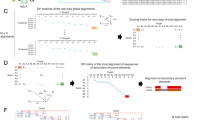Abstract
An amino acid sequence pattern conserved among a family of proteins is called motif. It is usually related to the specific function of the family. On the other hand, functions of proteins are realized through their 3D structures. Specific local structures, called structural motifs, are considered as related to their functions. However, searching for common structural motifs in different proteins is much more difficult than for common sequence motifs. We are attempting in this study to convert the information about the structural motifs into a set of one-dimensional digital strings, i.e., a set of codes, to compare them more easily by computer and to investigate their relationship to functions more quantitatively. By applying the Delaunay tessellation to a 3D structure of a protein, we can assign each local structure to a unique code that is defined so as to reflect its structural feature. Since a structural motif is defined as a set of the local structures in this paper, the structural motif is represented by a set of the codes. In order to examine the ability of the set of the codes to distinguish differences among the sets of local structures with a given PROSITE pattern that contain both true and false positives, we clustered them by introducing a similarity measure among the set of the codes. The obtained clustering shows a good agreement with other results by direct structural comparison methods such as a superposition method. The structural motifs in homologous proteins are also properly clustered according to their sources. These results suggest that the structural motifs can be well characterized by these sets of the codes, and that the method can be utilized in comparing structural motifs and relating them with function.
Similar content being viewed by others
References
Bairoch, A., Bucher, P., and Hofmann, K., Nucl. Acid Res., 1997, vol. 25, pp. 217–221.
Henikoff, S. and Henikoff, J.G., Genomics, 1994, vol. 19, pp. 97–107.
Attwood, T.K., Beck, M.E., Flower, D.R., Scordis, P., and Selley, J.N., Nucl. Acid Res., 1998, vol. 26, pp. 304–308.
Bernstein, F.C., Koetzle, T.F., Williams, G.J., et al., J. Mol. Biol., 1977, vol. 112, pp. 535–542.
Berman, H.M., Westbrook, J., Feng, Z., et al., Nucl. Acid Res., 2000, vol. 28, pp. 235–242.
Wako, H. and Yamato, T., Protein Eng., 1998, vol. 11, pp. 981–990.
Kasuya, A. and Thornton, J.M., J. Mol. Biol., 1999, vol. 286, pp. 1673–1691.
Author information
Authors and Affiliations
Rights and permissions
About this article
Cite this article
An, J., Wako, H. & Sarai, A. Analysis of Protein Structural Motifs in Terms of Sets of Codes Representing Local Structures. Molecular Biology 35, 905–910 (2001). https://doi.org/10.1023/A:1013250721578
Issue Date:
DOI: https://doi.org/10.1023/A:1013250721578




